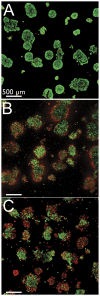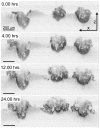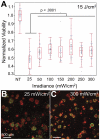Killing hypoxic cell populations in a 3D tumor model with EtNBS-PDT
- PMID: 21876751
- PMCID: PMC3158086
- DOI: 10.1371/journal.pone.0023434
Killing hypoxic cell populations in a 3D tumor model with EtNBS-PDT
Abstract
An outstanding problem in cancer therapy is the battle against treatment-resistant disease. This is especially true for ovarian cancer, where the majority of patients eventually succumb to treatment-resistant metastatic carcinomatosis. Limited perfusion and diffusion, acidosis, and hypoxia play major roles in the development of resistance to the majority of front-line therapeutic regimens. To overcome these limitations and eliminate otherwise spared cancer cells, we utilized the cationic photosensitizer EtNBS to treat hypoxic regions deep inside in vitro 3D models of metastatic ovarian cancer. Unlike standard regimens that fail to penetrate beyond ∼150 µm, EtNBS was found to not only penetrate throughout the entirety of large (>200 µm) avascular nodules, but also concentrate into the nodules' acidic and hypoxic cores. Photodynamic therapy with EtNBS was observed to be highly effective against these hypoxic regions even at low therapeutic doses, and was capable of destroying both normoxic and hypoxic regions at higher treatment levels. Imaging studies utilizing multiphoton and confocal microscopies, as well as time-lapse optical coherence tomography (TL-OCT), revealed an inside-out pattern of cell death, with apoptosis being the primary mechanism of cell killing. Critically, EtNBS-based photodynamic therapy was found to be effective against the model tumor nodules even under severe hypoxia. The inherent ability of EtNBS photodynamic therapy to impart cytotoxicity across a wide range of tumoral oxygenation levels indicates its potential to eliminate treatment-resistant cell populations.
Conflict of interest statement
Figures








References
-
- Berek JS, Bast RCJ. Kufe DW, Pollack RE, Weichselbaum RR, Bast RCJ, Gansler TS, et al., editors. Ovarian Cancer.
-
- Tannock IF, Lee CM, Tunggal JK, Cowan DSM, Egorin MJ. Limited penetration of anticancer drugs through tumor tissue: a potential cause of resistance of solid tumors to chemotherapy. Clin Cancer Res. 2002;8:878–884. - PubMed
-
- Jain RK. Delivery of molecular and cellular medicine to solid tumors. J Control Release. 1998;53:49–67. - PubMed
-
- Teicher BA. Hypoxia and drug resistance. Cancer Metastasis Rev. 1994;13:139–168. - PubMed
Publication types
MeSH terms
Substances
Grants and funding
LinkOut - more resources
Full Text Sources

